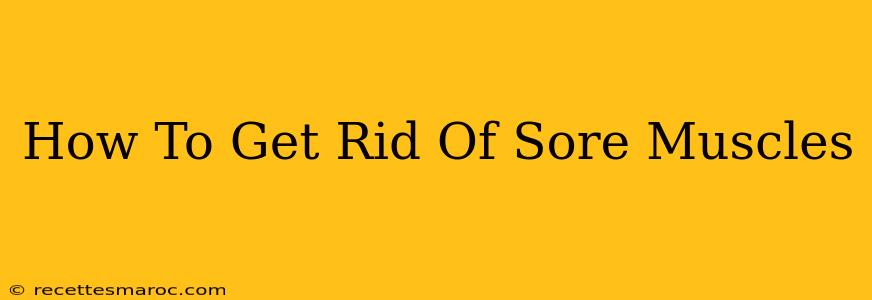So, you've pushed yourself a little too hard at the gym, tackled a new DIY project, or maybe just had an unusually active day. The result? Those familiar aches and pains of sore muscles. It's a common experience, but thankfully, there are plenty of ways to find relief and speed up your recovery. This guide will explore effective methods to get rid of those nagging sore muscles and get you back to feeling your best.
Understanding Muscle Soreness
Before we dive into solutions, let's understand what causes muscle soreness. Delayed-onset muscle soreness (DOMS) is the most common type, typically appearing 12-72 hours after strenuous exercise. It's caused by tiny muscle tears that occur during intense physical activity. While it's uncomfortable, it's usually a sign that your muscles are adapting and growing stronger.
Types of Muscle Soreness
- Acute Soreness: This appears immediately after exercise and is usually mild, disappearing quickly.
- Delayed-Onset Muscle Soreness (DOMS): This is the more intense, lingering soreness that sets in 12-72 hours after exertion.
Effective Ways to Get Rid of Sore Muscles
Now that we understand the cause, let's explore the best ways to alleviate that muscle soreness:
1. Rest and Recovery
This might seem obvious, but rest is crucial. Allow your muscles time to repair themselves. Avoid strenuous activity that aggravates the affected area.
2. Gentle Movement and Stretching
While complete rest is important, gentle movement and stretching can actually help. Light cardio, such as a short walk, can increase blood flow to the muscles, promoting healing. Static stretching, holding a stretch for 15-30 seconds, can help alleviate muscle tightness. Avoid intense stretching that could further injure already sore muscles.
3. Heat and Cold Therapy
Both heat and cold can be effective, depending on the stage of your soreness:
- Cold Therapy (Ice): Apply ice packs to the affected area for 15-20 minutes at a time, several times a day. This helps reduce inflammation and numb the pain.
- Heat Therapy: After the initial inflammation subsides (usually after 48 hours), heat can help relax muscles and improve blood flow. Warm baths, showers, or heating pads can be beneficial.
4. Self-Massage and Foam Rolling
Self-massage and foam rolling can help break up muscle knots and improve circulation. Gently roll the affected area, focusing on areas of tightness. Pay attention to your body; if it hurts, stop.
5. Over-the-Counter Pain Relief
Over-the-counter pain relievers, such as ibuprofen or naproxen, can help reduce pain and inflammation. Always follow the instructions on the label.
6. Hydration
Staying hydrated is essential for muscle recovery. Water helps to flush out waste products and deliver nutrients to your muscles.
7. Nutrition
A balanced diet plays a vital role in muscle repair. Ensure you're consuming enough protein to support muscle growth and repair.
8. Epsom Salt Baths
Soaking in a warm bath with Epsom salts can help relieve muscle soreness and inflammation. The magnesium in Epsom salts is believed to help relax muscles.
9. Compression
Compression garments can help improve blood flow and reduce swelling. They're particularly helpful after intense exercise.
10. Professional Help
If your muscle soreness is severe, persistent, or accompanied by other symptoms, consult a doctor or physical therapist. They can help diagnose the cause and recommend appropriate treatment.
Preventing Muscle Soreness
Preventing muscle soreness is often easier than treating it. Here are some preventative measures:
- Warm-up properly before exercise.
- Cool-down after exercise.
- Gradually increase the intensity and duration of your workouts.
- Listen to your body and rest when needed.
- Maintain good posture.
By understanding the causes of muscle soreness and implementing these strategies, you can effectively manage and alleviate discomfort, allowing you to return to your activities feeling refreshed and revitalized. Remember, consistency is key – incorporating these habits into your routine will contribute to long-term muscle health and well-being.

